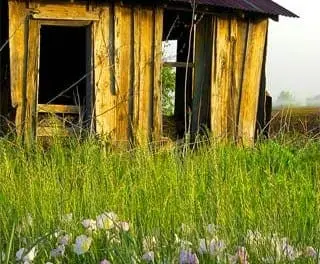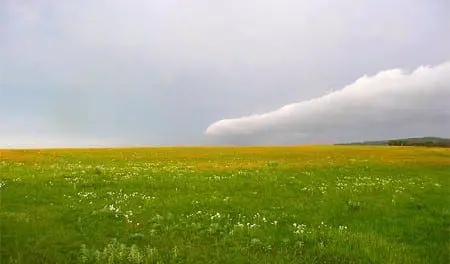DPA Magazine
Get Some Foreground to Add Depth
Location: A few miles south of College Station TX on Hwy 50. Its a great country road with lightly rolling hills and a broad mix of country, farming, ranching, creeks and streams. And no doubt lots of spring flowers! © 2007 Joe Robbins, Houston DPA Instructor Tips: #1: Next time you take a drive to get some new images, get going early before sunrise to get the light - but don′t be discouraged if its foggy like it was the morning I set out to take this shot. I decided I′d make the fog a part of the theme or feel of any shots I found along the way. In the case of this ol shack, I got lucky with the early warm sun popping through the fog, and the fog still drifting in the background of the shot. #2: Get some foreground in your shot to add depth and added interest. #3: Choose a shooting angle that is not the norm; high or low to add some drama, or in this case to get down where the nice flowers were popping out of the high grass. #4: Stop down on the aperture to get that foreground sharp in addition to the main subject in the background, again, like I was able to do with the flowers. #5: Use a tripod to get it sharp.
Clouds and Coastal Shots
Haystack clouds was shot at Cannon Beach on the North Oregon coast. It is on the coast highway about 40 miles south of the Washington-Oregon border. I use it to illustrate how great the clouds are in the spring and how fast they change. Coastal shots are "clean" in the mid spring before school lets out and the crowds arrive. Gives you uncrowded beaches and wonderful light. Haystack Clouds: © 2007 Ken DeJarlais, Seattle DPA Instructor
Big Skies!
Nothing says open space quite like a landscape defined by little more than big sky and continuous ground. In this image, stratified layers of color transition through various shades of green, yellow and blue, delineating a compositional plane and horizon. We find a soothing calm in the rendering of earth and sky in minimal content and form, which is interrupted dramatically, however, by the comet-like trail of the cloud. Notice how the cloud pierces the sky from the right side of the image. It, too, is linear and parallel to the horizon, but unlike the confluent fields of color it interrupts, the cloud’s shock of white vapor is not carried across the entire photo, its terminal point being very clearly defined at center-frame. This difference suggests dynamic movement against a background of stillness across the composition’s painterly landscape. Notice how the white flowers in the lower part of the image are crisp, while the defining line of the horizon is nevertheless distinct. In Simple Mode, the Panasonic Lumix DMC-TZ3 chose a depth of field that allowed sharpness from foreground to background. © Angilee Wilkerson, Dallas DPA Instructor
A Neat Trick on the River
Photo Location: Chestatee River in the north Georgia Mountains. Photo Tip: To shoot a canoe in a river, you need to rig the canoe so that it won′t move. I set a cable across the river and tied the canoe to the cable. Then my subjects could paddle all they wanted without going anywhere. I was able to make the shot at my leisure! © 2007 Joel Silverman, Atlanta DPA Instructor
Use Off-Camera Flash
A saguaro cactus offers up its yearly bloom along the Mount Lemmon Highway in Tucson, Arizona, where each Spring the large cactus can be seen flowering toward the end of April and through May. Mount Lemmon is an excellent area to take great springtime photos as its vegetation offers a wide variety from desert cactus to mountain top pinetrees. Deer, javelina, coyotes, and gila monsters make the mountain their home, which is in the Santa Catalina Mountain Range in the Northern part of Tucson. Photo tip: Use your off camera flash to help illuminate a subject as was done here,even "painting" a subject with many flashes, and just because the daylight is gone, doesn′t mean you can′t stop taking pictures. © 2007 David Sanders, Phoenix DPA Instructor
Using your Flash for Fill
Here is a portrait where I′ve used the sun as a side light and filled in light on the subjects face with a flash to lessen shadows and brighten her eyes. Make sure to balance the flash with the ambient sunlight to make the lighting look natural. In this image the flash is off camera controlled wirelessly so the flash can be placed to camera left... Anthony Brett Schreck Photo Tip #2 Use Your Flash for Fill! All images © Anthony Schreck Minneapolis DPA Instructor Here is a portrait where I′ve used the sun as a side light and filled in light on the subjects face with a flash to lessen shadows and brighten her eyes. Make sure to balance the flash with the ambient sunlight to make the lighting look natural. In this image the flash is off camera controlled wirelessly so the flash can be placed to camera left. Here are some examples without flash fill and with flash fill dialed down .7 of a stop to look natural and not overpower the subjects face with flash. Remember, If your flash is set to auto your camera may read that there is enough light and not turn the flash on. Set your flash to always fire. The two images below were shot with the Panasonic Lumix L1 with the on camera flash set to off in one (to show the shadows) and the flash set to always fire and flash compensation set -.7 in the other.
Take a Tip from the Kids!
Minneapolis Digital Photo Academy instructor Anthony Schreck gets photo tips from his kids, exploring new angles and having fun while he′s shooting! Anthony Brett Schreck Photo Tip #1 Take a tip from the kids! All images © Anthony Schreck, Minneapolis DPA Instructor As a parent most people use their camera to record the history and memories of their children. "Sit still! I want to take your picture." How many times did we hear that when we were kinds? Now, how many times do we say it when we want that great portrait of our children? We need to take a tip from them. Watch them at play, constant motion, never still with both feet on the ground. They are flurries of activity, climbing, jumping, rolling on the ground. We must do the same! We get stuck so often in trying to stand still and hold the camera steady that we miss some great images. Or, they all look the same because they are all shot from the same level. The eye level of how tall we are. This first images is of my daughter at Central Park in MN; right behind my house. To get it I had to jump up off my feet, climb on top of those old monkey bars, roll into position and cheer her on to keep going and going as my Camera clicked away, my lens zooming in and out to get the monkey bars to lead into the rung framing her face. I had to keep monitoring the spring clouds that kept giving me nice soft light. My legs staining tight around the bars to keep me from falling off. I was a flurry of activity to get that shot! Climb up to get a more dynamic perspective, or if laying on the ground works better do that. In Image 2 (below) I had to lay flat on the ground in order to "de-clutter" the background so there was nothing but clouds and sky behind my other daughter. Let the kids play, we should do the work. The smiles will be bigger and more natural at play than when they are asked to sit still and sit up straight or look here...etc. They′re doing all the "work" that way and we′re just clicking a button. So, take a tip from the kids, be active.
Landscapes: How to do it all!
Knowing how to photograph an eye-catching landscape is an important skill. Not only will it allow you to relive the moment of your encounter with a majestic mountain or your day-trip to the beach, there’s the benefit of creating a work of art you can proudly display. Russ Burden, professional photographer and an instructor at the Panasonic LUMIX Digital Photo Academy in Denver, discusses some key tips to capture that perfect landscape photo. Digital Photo Academy is a nationwide series of classes for all digital camera owners who want to maximize their cameras’ features and create more rewarding photo experiences. Available to beginning, intermediate, and advanced photographers, these classes are geared to specific levels so no student gets overwhelmed or lost. Russ’s landscape tips are just a preview of the many to be offered at the academy. © 2007 Russ Burden, Denver DPA Instructor Landscape Photography Tips Time of day. When you take a landscape photo, time of day is one of the critical factors to consider. I can’t stress enough that it’s “all about the light.” The angle at which the light strikes the subject in conjunction with the time of day the image is made greatly effect the success of the photo. The best shooting occurs at “sweet light” – when the highest quality of light imparts warm tones and soft illumination. Sweet light peaks during the first thirty minutes of a sunrise and during the last 30 minutes of a sunset. During this time, you’ll find the most advantageous shades of yellow, red and orange filtering through the horizon. If you’re using a DSLR, look for a white balance feature that will act as a built-in warming filter. For instance, the LUMIX DMC-L1 has a “cloudy” white balance setting that enhances beautiful sunsets and sunrises. Direction of light. Governed by subject matter, the direction of light can make or break an image. Frontlight can be very effective when trying to capture an evenly lit subject without any shadows or textures. Front light may yield a “nice” photo, but its lack of depth makes it a poor choice for shooting landscapes. So instead, work with sidelight. It provides increased textures, patterns and shapes and suddenly your subject becomes defined. How you use the shadows and lighting can create unbelievable highlights of the peaks and valleys of your subject, really letting the photograph pop, as though it’s three dimensional. Depth of Field. In landscape photography, it’s essential that all elements be in focus and have a consistent level of sharpness in the foreground, middleground and background. This requires having the maximum amount of depth of field, taking into account three fundamentals: the working aperture, the focal length of the lens, and the subject distance from the camera. It’s best to use a wide angle lens in the range of 28mm. You can get increased versatility by using a point-and-shoot, such as the Panasonic LUMIX DMC-TZ3, which not only features a 28-mm lens and 10x optical zoom, but its compact form factor lets you quickly zoom in and out, letting you capture the bird that unexpectedly entered the shot. © 2007 Russ Burden, Denver DPA Instructor Filters. There are two filters no landscape photographer should be without: the graduated neutral density and the polarizer. The polarizer removes glare from reflective surfaces so colors become more saturated. By removing surface reflections, the color of the subject is better translated to the image sensor. Additionally, if you’re shooting a subject 90-degrees from sun, it helps saturate the blue of the sky and makes the clouds really pop. The graduated neutral density filter helps tame contrast when making photos at the beginning and end of the day. By simply placing the dark part of the filter over the lens so it tones down the brighter part of the image, the contrast is reduced allowing the image sensor to capture details in both the shadow and highlight areas. Go beyond the obvious. Finally, remember that photography is an art – so don’t forget to show your creativity by looking beyond the obvious shot. Whatever subject inspired you to point your lens towards it in the first place – don’t be complacent with just one shot. Instead – “exhaust all possibilities.” If you took a shot of the mountains horitzontally, flip your camera and take it vertically. If you photographed a field of flowers from a standing position, get on your stomach and shoot it from eye-level to create a unique perspective. You’ll be surprised by the interesting shots that were not obvious at first, but prove to be priceless. © 2007 Russ Burden, Denver DPA Instructor To learn more photography tips, sign-up for Digital Photo Academy in one of the 20 cities where courses are available. For more information about Russ Burden’s nature photo tours, visit www.russburdenphotography.com.
I.M.P.A.C.T.
I.M.P.A.C.T. Russ Burden provides tips with the acronym I.M.P.A.C.T. to make your images really pop. I = Isolate M = Manual P = Polarizer A = Act C = Color T = Telephoto I.M.P.A.C.T. by Russ BurdenRuss Burden provides tips with the acronym I.M.P.A.C.T. to make your images really pop. Images with impact grab you as soon as they’re seen. The raising of the flag over Iwo Jima and the similar shot of the firemen hoisting an American flag at the site of the World Trade Center are two that reflect this concept. There are so many more classic images that have impact but the focus of this article is not about the ones that are already out there. It’s about the ones I want you to go out and make. They may never win a Pulitzer, but that doesn’t detract from the fact the photo has impact. Think about when you′re at your local camera club on a competition night and an image pops up that makes you say WOW. This is an image with impact. The same can be said for when you’re looking through magazines, at a museum, or any other location where pictures are on display. If they have the WOW factor, they have impact. © 2007 Russ Burden, Denver DPA Instructor You may be asking yourself, why does the title of the article have periods in between the letters of the word? The answer is simple. I.M.P.A.C.T. is a word I came up with to get you to remember good photographic technique so you can create images with impact. I = Isolate; M = Manual; P = Polarizer; A = Act; C = Color; T = Telephoto. So why did I choose these words? In that the accompanying photos depict the words - Isolate, Act and Color, I’ll explain the other letters first. The M for Manual relates to both shooting in manual mode and to get you to read your camera manual. First off, take your camera off program to get to learn more about the interaction between shutter speeds and apertures. This can also be done by shooting in aperture or shutter priority, but manual will really get you to learn the basics. The other idea of manual is for you to read, and I mean really read your camera manual. If you haven’t, I’m sure there are settings on the camera you don’t even know about. My manual is highlighted and has sticky tabs so I can access the most important aspects in an instant. At least twice a year, I review the manual so all controls remain fresh in my head. The P represents a Polarizer and should remind you to always bring a polarizing filter to give your pictures more pop and color. It’s the one filter that digital optimizing has yet to find a way to mimic - this is a good thing as it will cause you to remember to use the filter. The T represents Telephoto and should remind you use not only your telephoto lenses more often, but to experiment with every lens you own when photographing every subject. Finding a unique angle will separate your photography from everyone else′s. © 2007 Russ Burden, Denver DPA Instructor In the image I chose for Isolate, it’s very obvious what the subject is. The hawk against the clear blue sky allows the bird to easily stand out. It’s the only subject in the picture. There is nothing to act as a distraction. The Act should remind you to act when the action is peak, when the expression is optimum, or whenever the decisive moment needs to be captured. Finally, the C image represents Color. Look for striking colors and how they play off each other. Both color harmony and contrast work well. Use the techniques above to get you to create images with IMPACT. © 2007 Russ Burden, Denver DPA Instructor To learn more about this topic, join me on one of my Photographic Nature Tours. Visit www.russburdenphotography.com and click on the NATURE TOURS button for more information. Also, pick up a copy of my new book, Amphoto’s Complete Book of Photography. You can purchase a signed copy directly from me or visit your local book store or Amazon. Contact me at [email protected] to order your signed copy.







